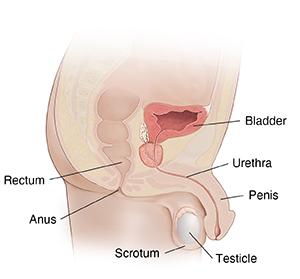What is cancer?
Cancer starts when cells in the body change (mutate) and grow out of control. Your body is made up of tiny building blocks called cells. Normal cells grow when your body needs them and die when your body does not need them any longer.
Cancer is made up of abnormal cells that grow even though your body doesn't need them. In most cancers, the abnormal cells grow to form a lump or mass called a tumor. If cancer cells are in the body long enough, they can grow into (invade) nearby areas. They can even spread to other parts of the body (metastasize).
Understanding the testicles
The testicles are the male sex glands and are part of the male reproductive system. Testicles are also called testes or gonads. They're behind and below the penis in a pouch of skin called the scrotum.
The testicles make sperm. Sperm are the male cells needed to fertilize a female egg cell and make a baby. The testicles also make male hormones, including testosterone. These hormones control the development of the reproductive organs. They also control other things, like body and facial hair and a lower voice.

What are the types of testicular cancer?
Germ cell tumors
More than 9 in 10 testicular cancers start in a type of cell in the testicles called a germ cell. These are the cells that make sperm. There are 2 main types of germ cell tumors: seminomas and nonseminomas. These 2 types occur almost equally. Many testicular cancers have both seminoma and nonseminoma cells. These are called mixed germ cell tumors.
Seminomas
Seminomas tend to grow slower than nonseminomas. They often respond very well to treatment. There are 2 types:
-
Classical (typical). More than 9 in 10 seminomas are classical. These are often found in men between ages 25 and 45.
-
Spermatocytic. These tend to occur later in life. The average age at diagnosis is 65.
Nonseminomas
These grow faster than seminomas. They tend to occur in men between their late teens and early 30s.
There are 4 main subtypes:
-
Embryonal carcinomas. This type tends to grow and spread quickly. Under a microscope, these tumors look like tissue in early embryos.
-
Yolk sac carcinomas. This is the most common form of testicular cancer in infants and boys. These are usually treated successfully when found in children. They can be harder to treat in adults.
-
Choriocarcinomas. This type is very rare and tends to grow fast. It often spreads quickly to other parts of the body, like the bones, lungs, and brain.
-
Teratomas. Under a microscope, these tumors look like the 3 layers of tissue in a growing embryo. They are rarely the only type of cancer cell in a nonseminoma.
Most nonseminomas are a mix of different subtypes. Sometimes seminoma cells are mixed in as well.
Stromal tumors
The stroma are tissues in the testicles that make hormones or support other tissues. Stromal tumors start in these tissues. There are 2 main types:
-
Leydig cell tumors. These tumors start in cells that normally make hormones. They are usually not cancer (benign).
-
Sertoli cell tumors. These tumors develop from cells that support and nourish the germ cells that make sperm. They're usually benign.
Overall, stromal cell tumors make up less than 5% of all adult cases of testicular cancer. But they are found in up to 1 in 5 childhood cases.
Secondary testicular tumors
Secondary testicular tumors are tumors made from cancer cells that started in another part of your body and spread to your testicles. For example, some kinds of lymphoma, a cancer of the lymph nodes, can spread to the testicles. In men ages 50 and older, secondary testicular cancer that starts as lymphoma is more common than tumors that start in the testicles. Other cancers that may spread to the testicles include lung, melanoma, kidney, and prostate cancer.